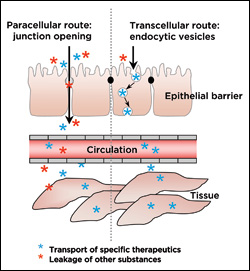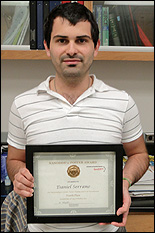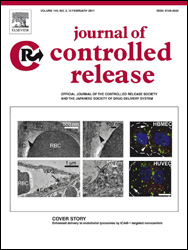News Story
Muro Group: Understanding Drug Delivery Via Natural Cell Pathway

Members of the Muro Group. Daniel Serrano appears 3rd from left.
One of the greatest challenges to success of nanomedicine technologies has been the difficulty of efficiently transporting therapeutics from the circulation, across the endothelial cells lining the blood vessels, and into tissues. Muro’s group has achieved this using cell adhesion molecule (CAM)-mediated endocytosis, a transport pathway that is reminiscent of the mechanism by which leukocytes travel from the bloodstream into tissues, and that remains relatively uncharacterized.
"Intercellular Adhesion Molecule 1 (ICAM-1) Engagement Modulates Sphingomyelinase and Ceramide, Supporting Uptake of Drug Carriers by the Vascular Endothelium," first-authored by Ph.D. candidate Daniel Serrano (Biological Sciences), focuses on the regulatory link between specific elements that are involved in endocytosis through ICAM-1. The research reveals a novel role for a specific lysosomal enzyme, acid sphingomyelinase (ASM), and the sphingomyelin/ceramide pathway in this process. The data suggest that endothelial cells can internalize and transport relatively large drug carriers that are targeted to ICAM-1.
These results will advance current knowledge on the regulation of CAM-mediated endocytosis related to leukocyte extravasation. In the long term, it may provide new tools for modulation of drug delivery therapies and result in more effective treatments.
According to Muro, the successful development of targeted drug delivery from the circulation into tissues represents one of the “Holy Grails” of modern medicine. In an editorial published in the same issue as her findings, Dr. Gregory Lanza of the Washington University Medical School agrees, suggesting the significance of the findings in the title of his own article, “Nature’s Doorway to the Extravascular Tissue Realm."
In addition to this research on ICAM-mediated endocytosis, Muro Group members study other mechanisms of endocytic vesicular transport, including their role in physiology and disease and their translational application for the controlled delivery of nanoscale therapeutics. Their work is sponsored by grants from the National Institutes of Health and the American Heart Association.
Story courtesy of and adapted from the original by Dr. Debrah Weinstein, IBBR.
Published June 29, 2012








